I am not a particular fan of poetry, except perhaps for the poetry of Edgar Allan Poe. Sometimes however an interesting story turns up on its own and that is the case with this month's story. I am going to tell you about an unusual poet who lived most of his life in San Francisco named Lionel Joseph. Before we take a look at his poetry, let's take a look at the poet.
Lionel E. Joseph was born May 26, 1876 in St. Louis, Missouri to Isaac Charles Joseph (1853-1919) and Caroline (Carrie) Bernard (1862-1920). Isaac Joseph was a bookkeeper by trade. He was born in Germany and came to the US on May 11, 1870. He applied for naturalization on September 5, 1871 and became a naturalized US citizen in New York in 1876. Caroline Bernard was born in 1862 in New York. Isaac and Carrie were married in New York in 1875.
History does not record what Isaac and Carrie Joseph were doing in Missouri when Lionel was born. Perhaps his time to be delivered took place when his parents were moving west. In any case by the time of the 1880 US Census the Joseph family was firmly ensconced in San Francisco, California. The family lived at 728 Harrison Street in San Francisco. A modern office building occupies that spot today. The family consisted of Isaac C. Joseph (32 years old), Carrie (22), and Lionel E. (4). Isaac indicated his occupation was "Bookkeeper."
There was a blessed addition to the family when Carrie gave birth to a sister for Lionel, Frances Gilbert Joseph (1886-1950) in San Francisco on May 23, 1886.
Lionel Joseph graduated from UC Berkeley with a law degree in May of 1897. He wasted no time in hanging out his shingle, joining attorney Thomas A. McGowan on the 5th floor of the Parrott Building on Market Street in pre-earthquake San Francisco.
 |
| The Parrott Building |
By 1898 Lionel Joseph, attorney-at-law decided to go out on his own, opening an office in the Claus Spreckels Building.
It appears that this trip to New York was more than a vacation. The San Francisco Chronicle from November 11, 1900 indicated that Joseph was back to San Francisco for a visit - and that he had been living in New York for "the last two years."
During this time, Joseph maintained an official residence with his parents at 1235 Geary in San Francisco. A modern apartment building occupies that site today. But the 1900 US Census finds him living as a "Boarder" at 55 West 92nd Street in the Upper West Side of Manhattan. An apartment building built in 1951 occupies that spot today. Joseph reported that his occupation was "Clerk and Author." Surprisingly he not only told the census taker that he had been born in California, he said that both of his parents had been born in California as well. Of course none of them had been born in California. Lionel said he had worked during the entire year of 1900 and that he could, of course, both read and write.
One of the first public offerings of young Joseph was a poem published in the Baltimore Sun newspaper of December 17, 1900 entitled "Of Things As They Are:"
The excerpt refers to the poem having been first published in the Century Magazine. The online archives for the Century are spotty and I was unable to locate that reference in the issues available online.
You will note that the poem is signed "Lionel Josaphare" not "Lionel Joseph". For some reason Lionel Joseph decided to adopt a pen-name and published under the name "Lionel Josaphare." Perhaps he thought Josaphare sounded more poetic, hence better for a poet. History does not record how or why he picked his pen-name. You will see it spelled both "Josaphare" and "Josephare" but Lionel himself always spelled it "Josaphare".
In 1901, Lionel Joseph published his first book, a book of poetry entitled "The Lion at the Well."


It is not a large book - only twenty-four pages - and it contains just two poems: "The Lion at the Well" and "The Grasshopper and the Butterfly." I am no judge of poetry. Like art and music I feel that it is a very personal thing. But here are excerpts so you can decide for yourself if you like it or not:
From "The Lion at the Well":

From "The Grasshopper and the Butterfly":
As mentioned in the Call clipping above, shortly after the release of "The Lion at the Well', early in 1901, Lionel Josaphare published his second book of poetry, "Turquoise and Iron" later that same year. This volume is larger - 104 pages - and contains twenty-four of his poems. A few examples of its contents:
Here is a lengthy (and not always complimentary) review from the San Francisco Call of December 8, 1901:

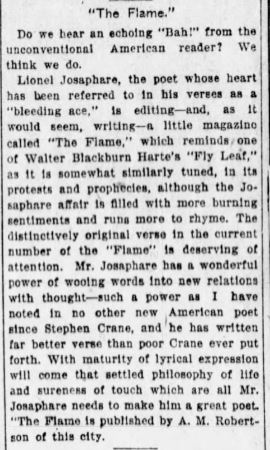
JOSAPHARE SINGS OF BOHEMIA
In Coppa’s, on the night of May seventh, there assembled that
bunch of Bohemians by which the little Italian restaurant that has survived
seismic disturbance and devastating flames was made famous. Lionel Josaphare was elected poet laureate
for the occasion. Porter Garnet wanted
the job, but he was barred, owing to the fact that since the catastrophe he
dropped out of journalism to become a hotel clerk. Josaphare commemorated the occasion in these
lines:
And twelve of us
wassailed in looted sauterne
Our hearts mid the
ruins still played the old games,
For the business
of hearts is to ruin and burn.
‘Twas at Coppa’s, where oft we had flung the confetti.
(We didn’t do
that – I aver the thing solely
To make the line rhyme with his wiggling spaghetti –
And also, in
passing, his famed ravioli)
Around us, Destruction has painted in black
The bricks and
the beams of the tumble-down city,
Night gave to the scene an impressionist smack
We pitied the
smash-up and danced in our pity.
Why not? In eternity
beauty is tinder,
There are graves
all around us, wherever we dance.
The city had fallen wide, cinder on cinder.
Like ghosts we
returned there and laughed in a trance.
Of the women and men of us, there was a best
A prettiest,
merriest, bravest in brawl.
Gladdest, loveliest, brainiest, quickest in jest.
Wisest,
staunchest, and finest and greatest of all
Gone where the subtle, risotto-fed waiters,
Sleek, sloe-eyed,
cash registering Felix was gone.
‘Twas a donation feast eaten by the donators
On one table only
our candles three, shone.
But around in the shadow a phantasmagoria
Of memories dined
with us, nodded and gleamed,
Dear unknown friends and many a glory a
Man would give
half of his soul to’ve redeemed.
There seemed the dim cheek my own oft pinked at;
(It’s blushing I
mean) and there the blonde lass
At whose onetime glances full often I’d winked at;
And there one to
whom I’d oft lifted my glass.
In fancy’s far colors they spectrally sat –
O lavenders,
purples, pale greys and faint yellows!-
The women asmile with Bohemian chat;
The maidens
light-laughing at devilish fellows.
When erstwhile we dined at the good center table,
We looked at
those people as mere decorations;
They figured us part of the show to enable
Them more to
enjoy their inane mastications.
A trick of the brain!
(“Tis easy for genius,
Though our food
had been recently quite unsublime-
A diet corn-beefy, mixed pickly, sardineous.
No matter); the
vision is gone for the time.
Thus hedged in with flame-eaten alleys and castles.
Full snugly at
Coppa’s we mumble and laugh
The camp-fires, the sentries, the night-bugling vassals.
Keep guard on the
street; to them let us quaff.
Good luck to the army that took such good care of us’
Good luck to the
earthquake that brought us all here’
The sounds of our city are gone from the fare of us.
To the music
that’s left let us still lay an ear
So here’s to the twelve of us! Here’s to the best.
And the
prettiest, merriest, bravest in brawl,
Gladdest, loveliest, brainiest, quickest in jest
Wisest staunchest
and finest and greatest of all.
In 1906, Lionel Josaphare was asked to fill out a card about his accomplishments for the California State Library Biographical Index project. Here's what he submitted:

Not bad for a thirty year old.

He also tried his hand at writing straight fiction. One of his works was called "The Fictitious History of the World." It appeared in Overland Monthly Magazine in February of 1910. Here is the first page:

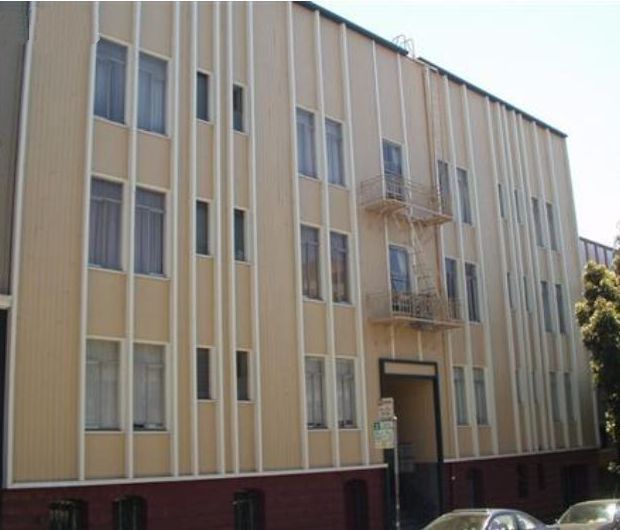 |
| 1040 Leavenworth Street, San Francisco |
 |
| 936 Leavenworth Street, San Francisco |
He listed his job as "Compilor" for Baker & Hamilton at 7th & Townsend in San Francisco. The building (which was built in 1905 and survived the 1906 earthquake and fire) still stands:
 |
| Masonic Home for the Aged, Decoto, California |
 |
| Photo courtesy Find a Grave volunteer FOIA |
 |
| San Francisco Coroner's Register |
 |
| Halsted & Co. Funeral Record |
 |
| Halsted & Co. Funeral Home, San Francisco |












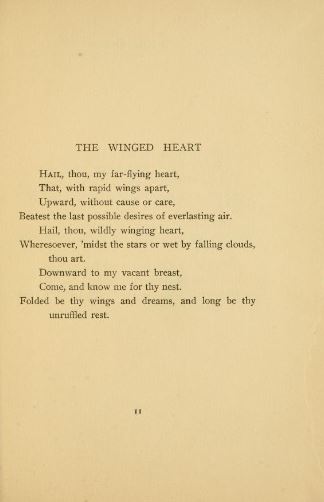






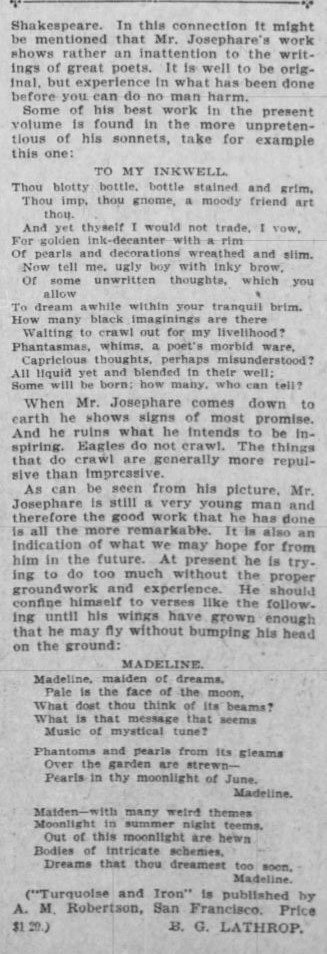
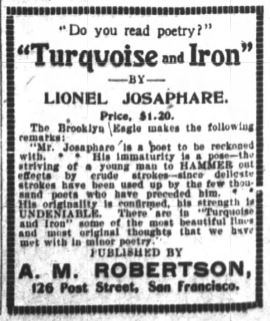

























.jpg)



.JPG)
No comments:
Post a Comment